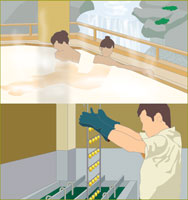Wastewater Treatment: Nonmetallic Element

@Nonmetallic Element-contaminated Wastewater Treatment Technologies targeted by the ETV Project (wastewater treatment technologies for boron, etc.: hereinafter simply called gNonmetallic Element-contaminated Wastewater Treatment Technologiesh) are the wastewater treatment technologies (equipment, etc.) for appropriately treating boron, etc., contained in hot spring wastewater from Japanese inns, etc., and plating wastewater from the plating / metal processing industry, etc. Among them, low-cost, compact, easy maintenance, commercial-ready technologies are targeted in particular.
About Nonmetallic Element-contaminated Wastewater Treatment Technologies
- Boron is one of nonmetallic elements. It does not exist as an elemental substance in the natural world; it exists as boron compounds such as borax and boric acid. In natural environments it is contained in river water, ground water, seawater, and soils. In particular, it is contained in hot spring water with relatively high concentration. Boron compounds are used in metal surface treatment, plating, glass making, glaze production for potteries, etc. Therefore, among the boron discharged into public water areas other than sea, natural ones mainly derive from hot spring, while artificial ones mainly derive from boron compounds used in the electroplating industry, the porcelain enamel glaze production industry, etc.
- There is a concern about the effects of boron on humans because diseases caused by the intake of high concentration boron have been reported and its effects were also pointed out in animal studies. Therefore, boron is designated as a water quality standard health item based on the Environmental Basic Act and a monitoring item of the drinking water quality standards based on the Water Supply Act. In addition, it is designated as one of the Class I Designated Chemical Substance in the gLaw Concerning Reporting, etc. of Releases to the Environment of Specific Chemical Substances and Promoting Improvements in Their Managementh (PRTR Law).
- Uniform wastewater regulations based on the Water Quality Pollution Control Act have been implemented for wastewater from factories, workplaces, etc. However, for some types of businesses mainly composed of small-scale establishments, tentative wastewater standards with lax regulation values were set. Although a certain level of boron discharge reduction has been attained by the implementation of the wastewater regulations, the effects of wastewater from small-scale establishments covered by the tentative wastewater standards cannot be ignored. Efforts to reduce boron discharge, such as the introduction of low-cost, compact, easy maintenance technologies, are expected for these small-scale establishments, too.